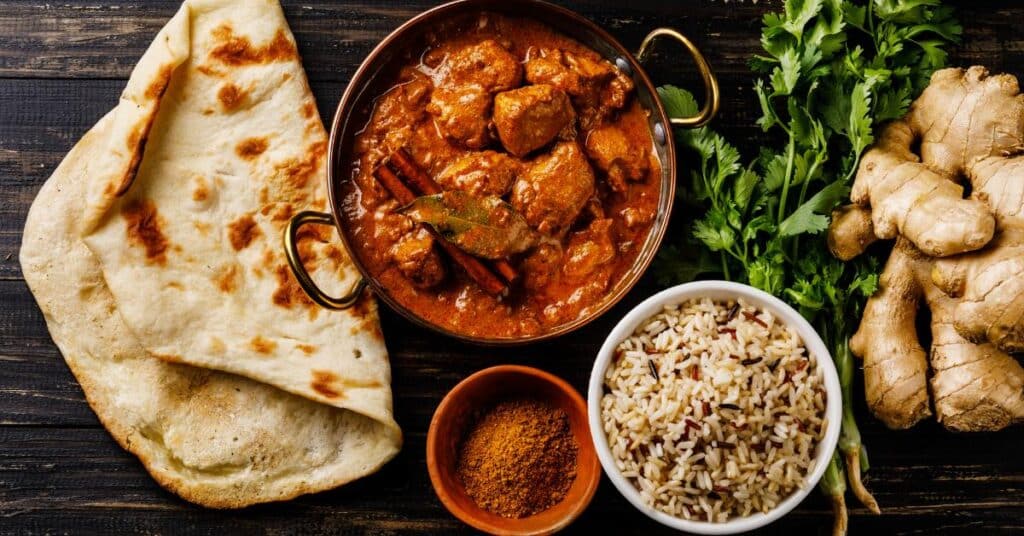
Curries are the heart and soul of many cuisines, bringing tantalizing flavors and a unique blend of spices to every dish. However, sometimes the spice levels can overwhelm even the most seasoned spice lovers. For those who find themselves reaching for a glass of milk or a spoonful of yogurt, there are several tips and tricks to help reduce the spice in your curry without losing out on the amazing flavors.
The key to managing a curry’s spicy kick is understanding its components and tailoring them to suit your palate. It’s essential to acknowledge the heat source, whether it’s from chili peppers, curry paste, or various spice powders, and temper these ingredients according to the desired spice level. Learning to navigate these flavor profiles will enable you to create a satisfying curry experience every time.
In this article, we will explore a few practical ways to make your curry dishes milder without compromising on taste.
Understanding the Heat in Curry
Capsaicin and Spiciness
Capsaicin is the compound responsible for the heat in spicy foods like curry dishes. It’s found in chili peppers, including cayenne peppers. When you consume capsaicin, it binds to pain receptors in your mouth, causing the sensation of heat and spiciness.
To control the heat in your curry, it’s essential to understand how capsaicin levels vary between different chili peppers. The Scoville scale measures the heat of a pepper based on its capsaicin content. Lower Scoville ratings indicate milder peppers, while higher ratings signal hotter varieties.
Chilli Powder and Varieties
Chilli powder is made from ground chili peppers, sometimes with additional spices. It’s a common ingredient used to add heat to curry. Different types of chili powders contain varying levels of spiciness, so it’s crucial to choose the right one for your desired curry heat.
Some common chili powders include cayenne, which has a Scoville rating of 30,000 to 50,000, and mild paprika, with a rating of 500 to 1,500. By experimenting with different chili powder varieties, you can adjust the heat in your curry to your personal preference. Remember, you can always add more heat, but it’s difficult to remove it once added.
Reducing Spice through Ingredients
Dairy Products
Dairy products are effective in taming spicy curries. Incorporating milk, cream or yogurt into the dish can help counteract the heat. For example, adding a dollop of yogurt can soothe the tongue from the spiciness while enhancing the overall flavors.
Potatoes and Vegetables
Potatoes have a special ability to absorb excess spice. Simply add a peeled and cubed potato, sweet potato, or even cucumber to the curry and cook until they become tender. Similarly, adding other vegetables such as carrots, cauliflower, or spinach can help balance out the heat.
Citrus and Acidic Ingredients
The addition of citrus and acidic ingredients can counteract spiciness. Squeeze lemon or lime juice into the dish, or try adding vinegar for an extra flavor twist. Also, adding a few chunks of fresh pineapple or cubes of papaya can help to neutralize the heat and create a refreshing taste.
Sweeteners and Nut Butter
Sweeteners, such as sugar or honey, can lessen the spiciness in a curry. A small amount of sweetener goes a long way in calming the heat without overwhelming the dish. Nut butter, like almond or peanut butter, are excellent alternatives for a vegan curry. Coconut milk and coconut cream are also popular choices, especially in Thai curries, as they add a rich, creamy texture along with reducing the spice level.
Adjusting the Recipe and Preparation
Diluting and Thinning the Curry
To reduce spiciness, dilute the curry by adding more liquid. This can be water, broth or coconut milk, depending on the curry base. Increasing the liquid content will spread the spice more thinly throughout the dish, lowering the heat level.
Adding Starch and Proteins
Incorporate starchy foods and proteins to minimize heat. For example, rice, potatoes, or pasta can be added to the curry to absorb some of the spiciness. Proteins like tofu, lentils, or chicken also help balance the flavors and reduce the overall heat.>
Another option is to mix in a few spoonfuls of peanut butter, which adds protein while also slightly thickening the curry. It will give the dish a slightly nutty flavor and help tame the heat.
Modifying the Curry Paste or Powder
Modifying the curry paste or powder used in the recipe is a proactive way to reduce heat levels. If you prefer milder curries, simply use less paste or powder. Additionally, look for milder curry pastes, or create your own by combining the individual spices in reduced amounts.
Remember, you can always cool down a curry by serving it with a side dish like cucumber yogurt or sweet chutney. Also, having a glass of milk nearby can help in case someone finds the curry still too spicy. Enjoy your curry with confidence knowing you can control the heat level to your liking.
Serving Recommendations
Accompaniments
To reduce spice in your curry, consider adding yogurt or raita as a side dish. Yogurt can help neutralize the heat, while raita, made from yogurt, mint, and fresh herbs, offers a cooling effect. You can also incorporate green papaya in your curry, as it contains enzymes that help break down proteins and can aid in reducing spiciness.
Be mindful of your choice of curry powders. Opt for milder ones, like coriander powder, and reduce the amount of chili powder used. You might also experiment with adding turmeric, an anti-inflammatory spice with a subtle flavor.
Refreshing Drinks
When serving a spicy curry, a cool, refreshing drink is a welcoming accompaniment. Options like fruit-based beverages or minty iced teas can help soothe the palate after a few bites of a spicy curry.
Carrots can be an excellent addition to your curry, not only for their natural sweetness but also for their texture. They can balance out the heat and create a more pleasant dining experience, ensuring your guests enjoy the meal without the overpowering spice.
